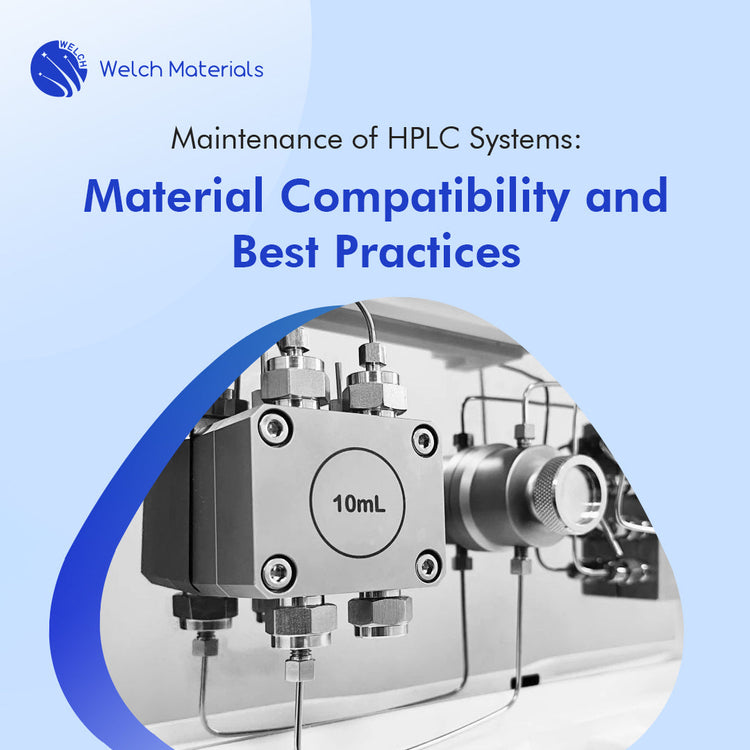Introduction
HPLC systems employ a variety of flow‑path materials whose compatibility with mobile phases is often underestimated. Inadequate attention to material–solvent interactions not only compromises data accuracy but also accelerates component wear and increases maintenance costs.
Drawing on real‑world examples and material specifications, this article highlights key characteristics of common HPLC materials and outlines practical maintenance strategies to help you avoid the hidden pitfalls in routine analyses.
Case Analyses
Case A: High Concentration Buffer Salt Usage
A laboratory repeatedly ran high‑concentration saline buffers without timely pump‑head maintenance. Over time, salt precipitation led to leaking seals and eventual corrosion of the pump head. Although 316L stainless steel resists common corrosives, accumulated salt crystals can breach seal integrity. Regular flushing and removal of salt deposits immediately after saline injections prevented further degradation.

Case B: PEEK Tubing Pressure and Solvent Compatibility
With a 2.6 µm, 250 mm column at 1.5 mL/min, system backpressure exceeded 20 MPa, causing PEEK tubing and fittings to fracture, resulting in leaks. Moreover, PEEK exposed to THF or DMSO under stress will swell, while acetone, chloroform, and concentrated sulfuric acid can cause cracking or dissolution within 20 minutes.

| Solvent | Effect on PEEK |
|---|---|
| Acetone | Cracking after 20 min |
| Methyl ethyl ketone | Slight cracking after 20 min |
| Toluene | Slight cracking after 20 min |
| Chloroform | Slight cracking after 20 min |
| Ethyl acetate | Slight cracking after 20 min |
| Concentrated H₂SO₄ | Complete dissolution |
Material Characteristics of HPLC Flow Paths
1. 316L Stainless Steel

Advantages: Molybdenum content enhances corrosion resistance; low cost; excellent for routine acid/base media.
Limitations: Vulnerable to concentrated inorganic acids and halogenated solvents.
Applications: pH 2–9 buffers; methanol/acetonitrile systems.
Incompatible: Concentrated H₂SO₄, HNO₃, high‑level chloroform, peroxide‑rich solvents, alkali halide solutions, EDTA-containing media.
2. PEEK

Advantages: Biocompatible; flexible; minimal biomolecule adsorption.
Limitations: Limited high‑pressure tolerance; swells in strong polar organics.
Applications: Ion chromatography; protein separations.
Incompatible: THF, DMSO, CH₂Cl₂, acetone, concentrated sulfuric acid.
3. PTFE

Advantages: Universal solvent resistance; low adsorption; broad temperature range.
Limitations: Deforms under extreme pressure.
Applications: Strong acid/alkali media; halogenated solvents; biopolymer analysis.
Incompatible: None—avoid combined high‑temperature/high‑pressure use.
4. Titanium

Advantages: High‑salt compatibility; minimal metal leaching.
Limitations: High cost; brittle.
Applications: High‑salt mobile phases; acidic reversed‑phase chromatography.
Incompatible: Ammonium chloride, phosphates, strong bases.
5. MP35N

Advantages: Exceptional corrosion resistance.
Limitations: Difficult machining; expensive.
Applications: Extreme high‑salt environments.
Incompatible: Extreme pH extremes; hydrofluoric acid.
6. Hastelloy C 276

Advantages: Outstanding corrosion and thermal stability.
Limitations: Reserved for the most aggressive conditions.
Applications: Aerospace and heavy‑chemical industries.
Importance of Biocompatible Flow Paths
Preserving Biomolecule Integrity
PEEK and PTFE components minimize nonspecific adsorption of proteins and peptides, ensuring sample activity and recovery, critical for monoclonal antibody and ADC analyses.
Enhancing Analytical Reliability
Low‑adsorption surfaces avoid sample carryover and maintain consistent retention times, improving method reproducibility.
Reducing Maintenance Burden
Corrosion‑resistant materials designed for high‑salt or extreme pH use diminish clogging and damage, extending instrument lifetime and lowering service frequency.

Maintenance Strategies
1. Material Selection Principles
Routine Analyses: Choose 316L stainless steel for methanol/acetonitrile and pH 2–9 buffers.
Biomolecular Assays: Opt for PEEK or PTFE to prevent adsorption of peptides and proteins.
Corrosive or Halide‑Rich Media: PTFE or Hastelloy C‑276 are preferred for strong acids, halogenated solvents, or high‑salt phases.

2. Key Component Care
Mobile Phase
- Use HPLC‑grade solvents and water; filter through 0.22 μm membranes.
- Degas thoroughly before use.
- Adhere to a defined shelf life based on solvent composition.

High‑Pressure Pump
- After saline buffers, flush pump head with compatible solvent to remove salt deposits.
- When switching between aqueous and organic phases, introduce isopropanol as a transitional rinse; follow saline runs with high‑water content, then organic solvent seal.
Autosampler
- Activate needle‑wash functions to prevent cross‑contamination; ultrasonic‑clean needle seat or valve when contamination occurs.
- Use flat‑tip, dedicated needles for manual injections; ensure full insertion depth and clean before/after each use.
- For viscous samples, reduce draw speed and verify liquid level to prevent mis‑aspiration.

Detector
- Light Source: UV lamps typically last ~2,000 h; use instrument diagnostics (“lamp energy test”) to determine replacement.
- Flow Cell: Avoid pH > 9.5 buffers to protect quartz windows; flush salt‑containing phases with pure water immediately post‑run to prevent blockages.
Welch Materials offers tailored HPLC systems of various materials—including 316L stainless steel, PEEK, PTFE, Hastelloy C‑276, and more—to meet diverse application requirements. For inquiries or custom configurations, please contact us at info@welchmat.com.

